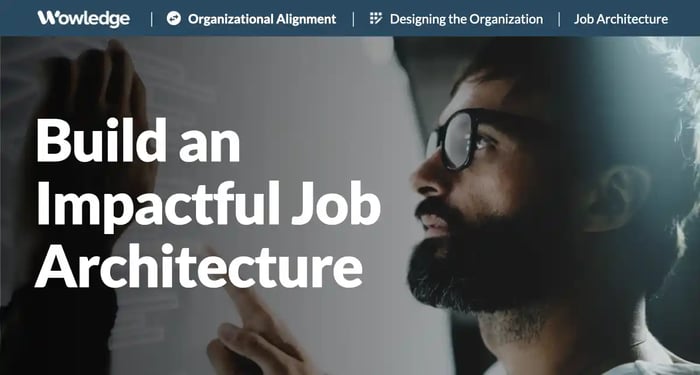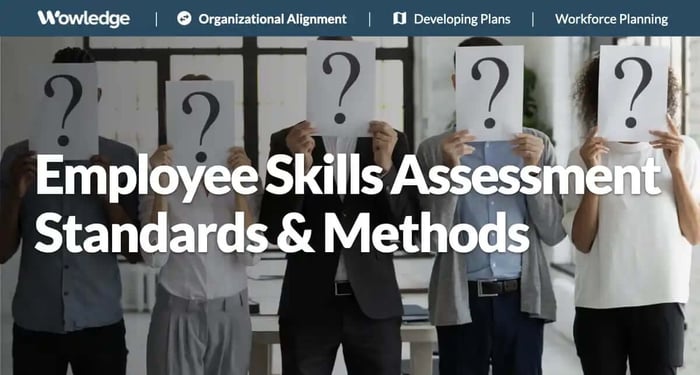Table of Contents
Job architecture is a fundamental framework within strategic human resource management that plays a critical role in defining the structure of an organization's workforce. At its core, job architecture encompasses the systematic organization and categorization of various job roles and positions within a company. The primary purpose of building a job architecture is to provide a clear and structured hierarchy of jobs, allowing organizations to understand how different roles relate to one another and how they contribute to the overall goals and objectives of the company. Job architecture goes beyond merely listing job titles; it considers the intricate details of each position, including responsibilities, required skills, and the level of influence or decision-making authority associated with them. A well-designed and executed plan can directly impact employee engagement and retention.
In the context of comprehensive job classification and compensation strategies, job architecture is the backbone upon which those are built. It helps HR professionals and compensation experts make informed decisions regarding job leveling, pay scales, and career progression within the organization. Building a job architecture ensures fairness and drives equity in compensation and career development by categorizing jobs based on their relative complexity, skill requirements, and responsibility. Additionally, it facilitates talent management efforts by providing a clear roadmap for employee growth and development, helping organizations attract, retain, and motivate top talent. Job architecture is an indispensable tool that fosters transparency, consistency, and efficiency in HR and compensation management, ultimately contributing to an organization's overall success.
When well designed and executed, its impact can be substantial. Recent research by Mercer found that 81% of employees felt at risk of burnout because they were not sufficiently rewarded for their efforts.
The primary objectives of implementing a job architecture
Building an impactful job architecture serves several primary organizational goals, all contributing to organizational effectiveness and efficiency. The primary objectives of implementing a job architecture include:
1. Clarity and Transparency
Provide clarity and transparency regarding the roles and responsibilities and their relative value within the organization. This includes defining job roles, expectations, reporting relationships, and the range of compensation associated with each position to help reduce confusion and ambiguity.
2. Fair and Equitable Compensation
Establish a fair and equitable compensation structure aligning with the organization's goals and values. A well-designed job architecture ensures that employees are compensated based on the value of their roles and responsibilities. Such comparisons are made relative to people performing similarly (and more objectively) valued work internally and externally in the relevant labor market(s).
3. Talent Management and Development
Support talent management and development by providing a clear framework for career progression. Job architectures outline career paths, skill requirements, and advancement opportunities, which motivate employees to invest in their professional growth within the organization.
4. Recruitment and Hiring
Facilitate recruitment and hiring processes by defining job roles, qualifications, and expectations. This provides clarity and direction to HR professionals and hiring managers as they work to target and attract candidates who best fit specific positions.
5. Performance Management
Improve performance management by aligning job descriptions and expectations with organizational goals. This supports managers in setting clear performance expectations and providing feedback directly linked to job responsibilities and requirements.
6. Succession Planning
Support succession planning efforts by providing a roadmap for career development, progression, and advancement within the organization. This directs high potentials on growth paths needed to ensure a talent pipeline ready to fill critical roles as they become available.
7. Market Competitiveness
Ensure the organization's compensation and structure are competitive within the job market. A well-designed structure simplifies benchmarking and market-matching of jobs and creates pay scales that help attract and retain top talent and remain competitive in the industry.
8. Legal Compliance
Ensure compliance with labor laws and regulations, particularly in pay equity, non-discrimination, and fair employment practices. Such a structure drives legal compliance via objectively assessed job levels that are defensible and thus reduce the risk of legal issues and penalties.
9. Data-Driven Decision-Making
Support data-driven decision-making by providing valuable data on job evaluations, market benchmarking, and career progression. This information can inform strategic decisions regarding workforce planning, resource allocation, and talent development.

The core elements of a job architecture
A job architecture refers to an organization's overall structure of jobs, roles, and responsibilities. It includes common elements, which can vary by company size, scope, and sophistication. Also referred to as job structure, job catalog, or leveling, it tends to include:
Job Functions
Key groupings of roles that align with recognized, often codified, professional domains or areas of expertise. These functions offer a structured way of categorizing jobs based on specialized fields or disciplines. Such functions encompass areas like operations, accounting, finance, engineering, procurement, and more, providing clarity on career trajectories and required skill sets within specific sectors.
Job Families
Clusters of related roles within a particular function that share a core purpose but vary in levels of responsibility, skill, and remuneration. Each family acts as a subset within the broader function, delineating roles based on their similarity and alignment. An example being the accounting family that spans from staff accountants to controllers, showcasing the breadth of roles within a single professional discipline.
Job Levels
Hierarchical categories denoting the stature of a position such as entry-level, mid-tier, or senior-level. These levels are critical in understanding an individual's current position in the career journey. They help clarify career trajectories, offering a clearer perspective on potential growth opportunities within and between families.
Job Roles/Titling Conventions
Generalized portrayals of the main tasks and duties linked with a position, often characterized by universally recognized titles like specialist, manager, or director. These conventions streamline communication about roles and responsibilities, ensuring that stakeholders, both internal and external, have a common understanding of a job's scope based on its title.
Job Descriptions
Comprehensive accounts of what a particular job entails, including tasks, qualifications, and its place within an organizational hierarchy. These descriptions serve as foundational documents for HR processes, from recruitment to performance evaluation. They not only guide prospective candidates in understanding role expectations but also steer existing employees in their day-to-day functions and developmental aspirations.
Competencies
The blend of knowledge, aptitude, and behavioral traits that underpin successful job performance. Competencies provide a framework for performance standards, guiding HR processes such as recruitment, training, and career growth strategies. They act as benchmarks to evaluate and develop an employee's readiness for various roles.
Career Ladders and Lattices
Illustrative charts mapping potential career advancement paths, either vertically within a function (promotions) or horizontally across functions (transfers). These visual aids provide employees with a clear understanding of possible career trajectories. They highlight the traditional, linear progression routes (ladders) and also the multidisciplinary, often non-linear pathways (lattices), especially in organizations that value versatile skill sets and cross-functional experiences.
The process of creating a job architecture
Building a job architecture is a critical component of effective human resource management. It systematically analyzes, evaluates, and organizes jobs to establish a clear hierarchy and structure. Creating a job architecture includes job analysis, job evaluation, benchmarking, and job leveling, followed by a quality and robust roll-out.
1. Establish objectives and gain stakeholder buy-in
Before diving into the process, define the objectives of creating a job architecture. Determine the primary goals, such as fair compensation, career progression, or organizational efficiency. Engage key stakeholders, including senior management, HR, and employees, as this process can significantly impact the organization. Develop a project plan clarifying tasks, timeframes, roles and responsibilities, resource requirements, and communications and change management activities.
2. Conduct job analysis
Job analysis involves gathering detailed information about each job within the organization. This typically includes reviewing existing documentation and collecting needed data (via job questionnaires, interviews, or expert panels) on each role, including tasks, responsibilities, qualifications, and reporting relationships. Clarify job specifications, including the skills, qualifications, and experience required for each role.
3. Perform job evaluation
Job evaluation is assessing the relative worth of each job within the organization. The most used methods for job evaluation are based on the resources available (typically an abundance or shortage of compensation consultants or internal team members).
- Point-factor method: Assign numerical values to factors such as skill, effort, responsibility, and working conditions. Each job's total points determine its relative value. This is the most used method.
- Ranking method: Rank jobs based on importance, with the highest-ranked job, considered the most valuable. This can be used with expert panels of managers facilitated by compensation expert(s).
- Job classification method: Group jobs into predetermined categories based on predefined criteria. This tends to result in various roles combined into individual groupings vs. job functions or families.
4. Conduct market pricing or benchmarking
Benchmarking involves comparing each role and/or job family in the organization's job structure to external data, such as national, regional, industry, and/or local standards and market rates. Conducted annually, this helps ensure competitiveness and alignment with the external job market. Use benchmarking data to assess the extent to which the organization's job levels and compensation are competitive and market-driven.
5. Create a job hierarchy and structure
After jobs have been evaluated and benchmarked, a clear job hierarchy and structure can be created. This typically involves grouping jobs into job families or job clusters based on skill requirements or functional similarities, assigning jobs to specific levels or grades based on their relative value and responsibilities, and developing a framework that visually represents the job architecture, often in the form of an organizational chart or matrix.
6. Perform job leveling
Job leveling aligns roles based on their relative worth, responsibilities, and contributions. This ensures internal equity due to its development of clear criteria for leveling jobs, such as the number of direct reports, complexity of tasks, decision-making authority, and strategic impact. Each job is subsequently assigned an appropriate job level within the established structure.
7. Implement and communicate
Building a job architecture involves updating job descriptions, job titles, and compensation structures. Those are then communicated to employees, managers, and stakeholders, explaining the rationale and benefits of the changes. Individual impacts (e.g., placement in a new title or grade, positioning in a new or updated pay range, etc.) are typically confirmed in writing and communicated/explained by an expert and the direct supervisor or manager.
8. Regularly review and adjust
As a job architecture is not static, it should be periodically reviewed and adjusted as the organization evolves, new roles emerge, or market conditions change. Updates to pay ranges are most typically benchmarked and developed annually, submitted for comment and impact analysis to Finance, and presented to top leadership for approvals.
Creating a job architecture is a complex and ongoing process that requires careful planning, analysis, and collaboration with key stakeholders. It is crucial in helping organizations manage their workforce effectively and remain competitive in the job market.

Output of a job architecture effort
The results of a comprehensive job architecture development activity typically consist of several core elements that help organizations define, categorize, and compensate the jobs effectively. It also defines the continuing use and management of the structured approach to classification and compensation with essential processes and documentation.
Standardized position groupings
Positions are grouped based on similar functions, duties, skills, and competency requirements, often finding similar positions in different functions and business units. The advantage of this is the simplification and standardization of roles and compensation across businesses, functions, and geographic boundaries.
Job levels or grades
Jobs are organized into levels or grades to reflect their relative importance, complexity, and seniority. Each level typically has a distinct set of responsibilities and expectations, and the compensation ranges are set to reflect the relative value both within the organization and the marketplace for the types of roles within them.
Compensation structure/pay scales
The job architecture directly influences the organization's compensation structure. It helps determine how jobs are paid relative to one another, which is crucial for ensuring internal equity and competitive pay internally and in the job market.
Career progression paths
Career progression paths outline how employees can advance within the organization, typically by moving from one job level or grade to another. These paths clarify opportunities for growth and development and leverage the job descriptions to provide insights into the requirements for successively higher roles and lateral moves across job functions or families.
Governance, review, and maintenance processes
A formal governance process that engages HR and business leaders should be installed to provide ongoing oversight and decision-making related to the architecture. A well-defined process for regularly reviewing and maintaining the job architecture is crucial to adapt to changing organizational needs, job market conditions, and evolving roles.
Critical process documentation
Detailed records of the job evaluation process are essential for transparency and accountability, including the factors considered, the point values assigned (if using a point factor method), and the resulting job evaluations. In the same way, market pricing/benchmarking data provides an invaluable comparison of the job architecture and compensation practices to industry standards and competitors over time. In the same way, communication and training materials should be retained and posted on the company intranet to educate employees, managers, and stakeholders about the job architecture, its purpose, and its impact on various HR processes, such as compensation, performance management, and career development.
These core elements work together to provide a structured framework for managing jobs within an organization, ensuring that roles are well-defined, that compensation is fair and competitive, and employees have clear paths for career development and progression.
The organizational impact of a great job architecture
A well-designed and effectively implemented job architecture can have numerous positive organizational impacts, contributing to the overall success and efficiency of the organization. Five critical talent and business outcomes are a result of effectively building a job architecture:
Enhanced transparency and workforce understanding. A clear and well-structured job architecture provides employees with a better understanding of their roles and responsibilities, as well as the roles of their colleagues. It provides continuous guidance on salary levels and the requirements for movement upward or across their current and future potential functions and departments. This clarity can reduce role ambiguity and broaden appreciation of what it takes to succeed in other roles.
Improved talent management. Job architecture helps organizations identify and develop talent more effectively. It provides a clear framework for talent attraction and hiring, career progression, and development paths, motivating employees to invest in their professional growth within the organization, directly impacting their retention. It guides leaders on the capabilities and competencies that differentiate top performers and future leaders.
Increased employee engagement and satisfaction. When employees perceive that their roles are well-structured and that their pay is reasonable and equitable, it can contribute to positive engagement and satisfaction. This enhanced sense of fairness can lead to higher retention rates and improved employee morale.
Fairer and more equitable compensation. Job architecture is crucial in establishing an organization's fair and equitable compensation structures. It provides a market-based structure attuned to internal consistency. It helps ensure that employees are compensated based on their roles' relative value and complexity, contributing to pay equity and reducing the risk of wage disparities.
Enhanced labor cost management. Creating a job architecture offers the ability to provide equitable compensation at levels that are consistent and quantitatively tied to national, regional, and local market rates. This helps ensure that all positions in an organization, regardless of their function or local manager preferences, are paid at rates that both business and market conditions can justify. Using pay ranges and compensation administration practices such as range placement guidelines, employee compensation can be made to fit the businesses’ ability to pay/afford labor at different levels and skill sets.
Relevant Practices & Tools
Core Organizational Design Practices To Align The Organization With Business Strategy. >
Organizational design includes activities to design and implement an organization that can enable the pursuit of the business strategy and organizational goals... more »
Defining Capabilities, Tasks, and Roles to Create Clarity and Accountability in the Organization. >
Capabilities are the know-how and expertise needed for an organization to create value. They are the backbone of the organization, and the organization should be designed to... more »
Constructing Career Paths to Identify Future Aspirational Roles. >
A career path (or “ladder”) is a logical progression of increasingly challenging jobs within a specified function that primarily includes vertical movement throughout an organization... more »
Defining Career Lattices to Define Robust Lateral and Vertical Mobility. >
The ability to enable the movement of employees proactively and strategically from role to role at the leadership, professional, and operational levels is a key flexibility... more »
The Skills Taxonomy Tool: Define and Organize Job-relevant Skills Used in Different Jobs Across a Company. >
A tool to categorize and define the abilities needed to perform jobs across the enterprise. It is a catalog that can be used in collecting and assessing the individual and aggregate... more »
FAQs
What governance model should oversee a job architecture after launch?
An effective model assigns decision rights to a cross-functional committee chaired by HR and Compensation, with Finance and business leaders as standing members. The group maintains leveling standards, approves exceptions, and schedules and oversees market reviews on a defined annual cycle. A small operations team executes changes, manages documentation, and audits usage for consistency. Clear charters and service level agreements (SLAs) keep requests moving and prevent drift from the original design.
How can an organization prevent title inflation while implementing job architecture?
Title frameworks should decouple external-facing titles from internal levels and require evidence-based criteria for movement. Gatekeeping mechanisms, such as management calibration sessions and promotion panels, validate scope, impact, and competencies before any level change. Consistent pay range controls and range placement guidelines reduce pressure to award inflated titles as a proxy for compensation. Communication materials should explain the difference between market-facing titles and internal leveling to reduce confusion.
What is a practical roadmap and timeline for building job architecture in a mid-size company?
Typical phases include discovery and scoping, job analysis and leveling, market benchmarking, manager calibration, and implementation with change management. A realistic duration runs four to six months, depending on scale, data quality, and decision speed. Early pilots in two or three functions help pressure-test leveling rules before enterprise rollout. A stabilization period follows to handle rework, documentation, and manager coaching.
How should acquisitions and reorganizations be integrated into an existing job architecture?
The acquiring organization should map incoming roles to the existing taxonomy using scope, impact, and competency criteria rather than legacy titles. Temporary “bridge” mappings preserve current pay levels and proposed upgrades (for equity and retention) while a structured leveling review determines long-term placement. Clear communication of equivalencies and timelines reduces uncertainty for acquired teams. Post-integration audits verify consistency and identify gaps that warrant taxonomy updates.










